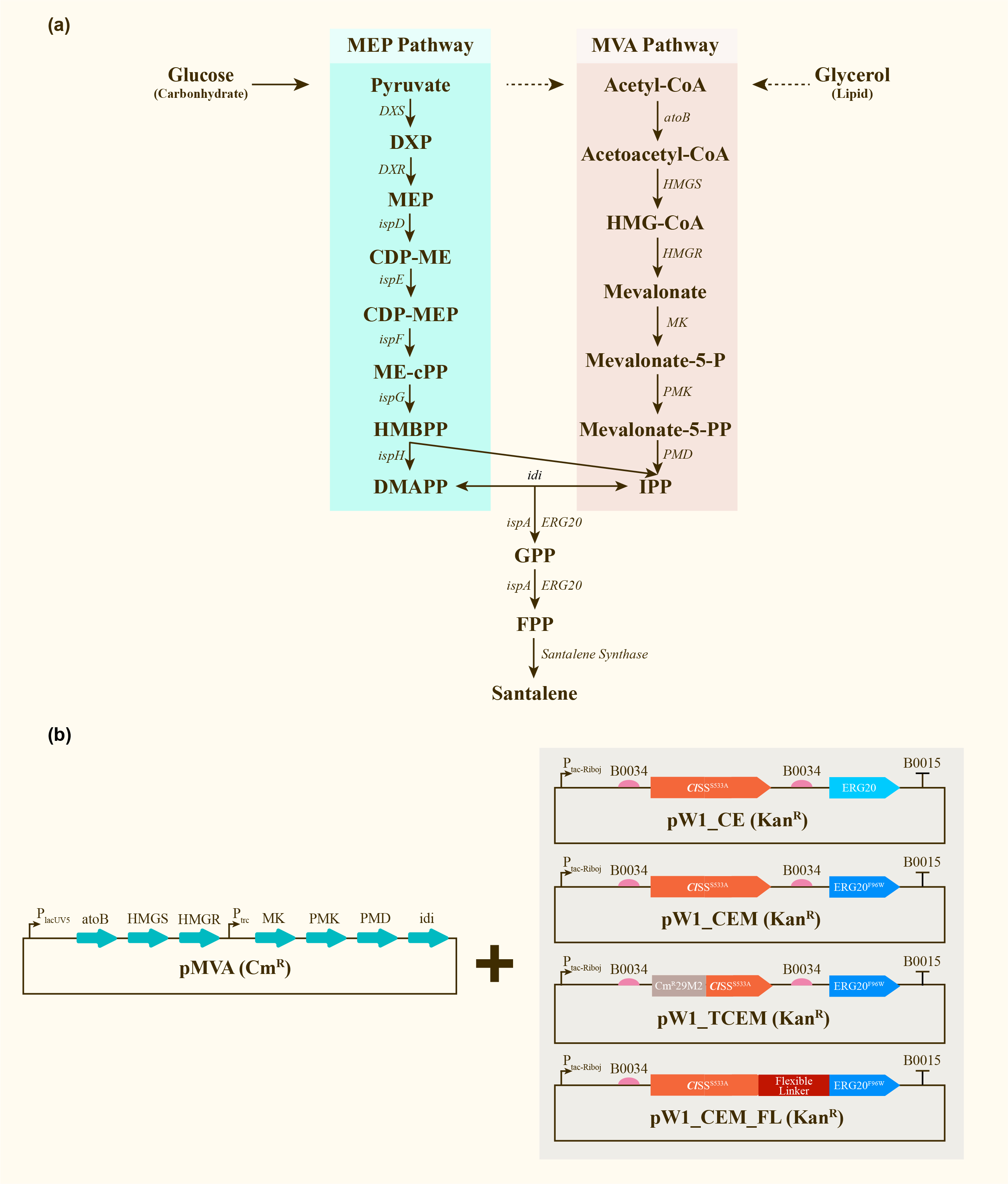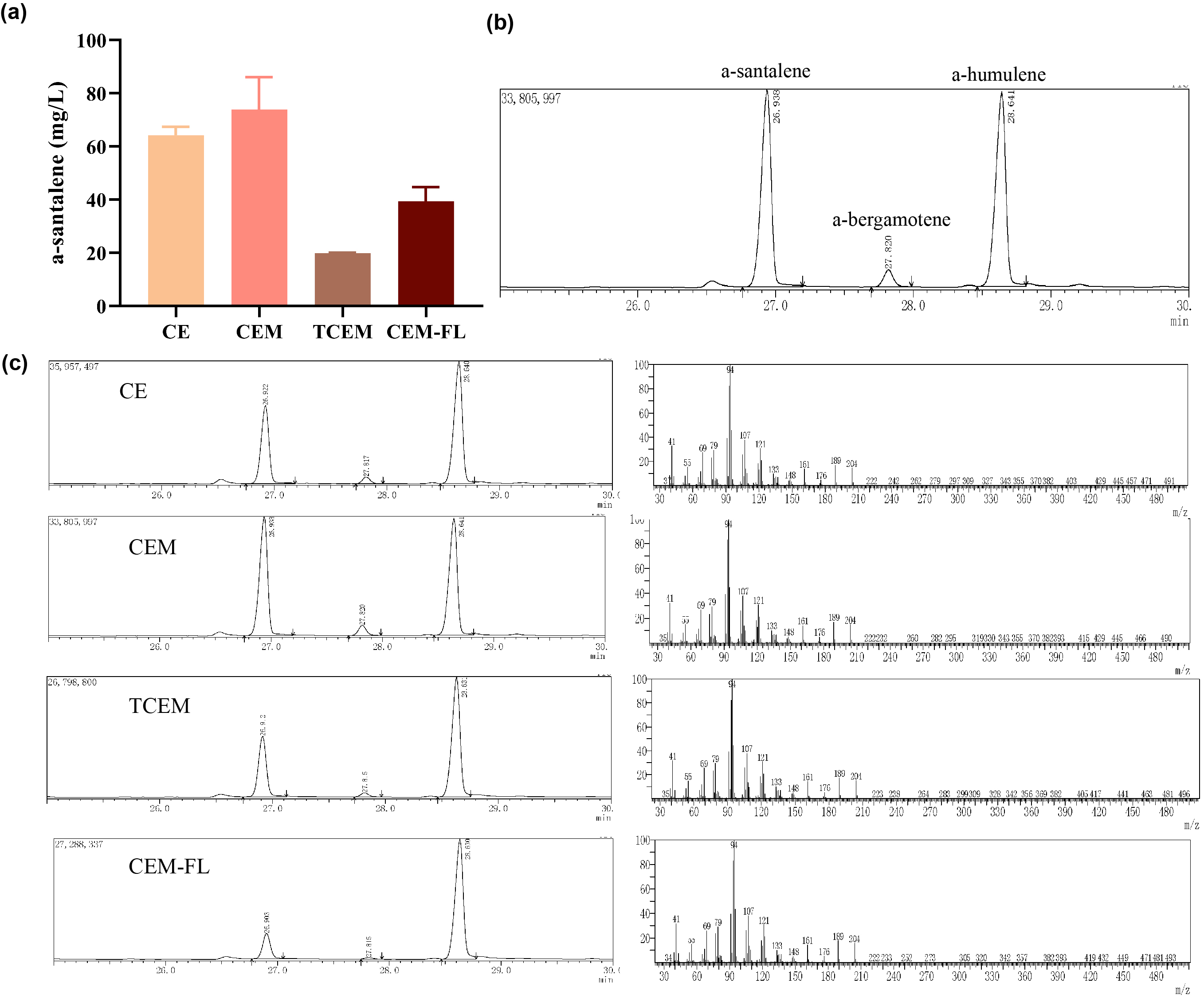Part:BBa_K4274033
ptac-RiboJ-B0034-ClSS_S533A-FL-ERG20_F96W-B0015
BBa_K3552015, BBa_B0034, BBa_K4274003,BBa_B0015
This composite part is designed for the pathway IPP ⇄DMAPP → GPP → FPP → alpha-santalene. It is used as a trial to express enzymes ClSS and ERG20 to its maximized extent, hence reaching the improvement of alpha-santalene production. It starts with the promoter ptac-RiboJ (Part: BBa_K3552015), following the ribosome binding site B0034 (Part: B0034). Then, we added the coding sequence for ClSS_S533A, followed by a flexible linker, and then ERG20_F96W. The part ends with the terminator B0015 (Part: BBa_B0015).
This part falls under our collection that produces alpha-santalene. We also have two parts that optimizes the activity of FPP (farnesyl diphosphate), consisting of ERG20_F96W (Part: BBa_K4274002), and ptac-RiboJ-B0034-ClSS_S533A-B0034-ERG20-B0015 (Part: BBa_K4274030). Parts secreting ClSS and ERG20, CmR29M2_ClSS_S533A (PART: BBa_K4274001) and ptac-RiboJ-B0034-CmR29M2_ClSS_S533A-B0034-ERG20_F96W-B0015 (Part: BBa_K4274032). Finally, this part, exploring the effects of fusion protein on secretion and santalene production (Part: BBa_K4274033).
This part collection aims to optimize the production of alpha-santalene, the precursor of santalol.
Usage and biology
ClSS_S533A (C. lansium santalene synthase) is the enzyme that catalyzes the transformation from FPP (farnesyl diphosphate) to alpha-santalene. Its 533rd amino acid has been artificially mutated from serine to alanine for the sake of optimization. ERG20_F96W is the enzyme that catalyzes the formation of FPP (farnesyl diphosphate). The 86th amino acid was mutated from phenylalanine to tryptophan. FL refers to the flexible linker that we have added in between the two proteins. It was hoped that adding a flexible linker can maximize alpha-santalene production. However, our results demonstrate the opposite, that alpha-santalene production decreased after adding a flexible linker.
Source
ClSS_S533A (Part: BBa_K4274000) is from Clausena lansium, ERG20_F96W (Part: BBa_K849001) is from S. cerevisiae, and CmR29 is from Synechocystis.
Characterization
After engineering, E. coli could utilize both MEP pathway and MVA pathway for the universal precursors isopentenyl diphosphate (IPP) and dimethylallyl diphosphate (DMAPP), then synthesize santalene with the help of FPP Synthase (FPPS) and santalene synthase (SS). Except heterologously expressed MVA pathway and ERG20 of Saccharomyces cerevisiae and santalene synthase of Clausena lansium (ClSS), several modifications upon ERG20 or ClSS by amino acid mutation, binding to a hydrophillic tag and the construction of fusion protein were tested for the higher yield of santalene. Therefore, with the help of the co-transformation of pMVA plasmid with various pW1 plasmids, including pW1_CE, pW1_CEM, pW1_TCEM and pW1_CEM_FL, different strains like CE, CEM, TCEM, CEM_FL were successfully constructed (Figure 1). The complete pathway we designed for producing santalene in E. coli is illustrated in Figure 1.

Afterwards, the various engineering of E.coli DH5α ∆TnaA mentioned above were used for santalene production. After rapid centrifugation, the supernatant of dodecane was spiked with with 0.475 g/L a-humulene as an internal standard, and then injected into GC/MS for verification of α-santalene production. It turned out that all samples from four strains appeared a significant peak at the retention time of 26-27 min, and various peak area of different samples exhibited santalene production with differing levels, indicating the general success of E. coli engineering. It can be concluded that the E. coli strain CEM (with pW1_CEM plasmid) produces the maximal level of α-santalene compared to other strains (73.93 mg/L). Furthermore, our study elucidates that the mutation of 96th amino acid into tryptophan could increase the yield of α-santalene by about 20%, substantiating the prominent performance of ERG20F96W in enhancing the supply of FPP and α-santalene production in E. coli (Figure 2).

Sequence and features
Sequence and Features
- 10COMPATIBLE WITH RFC[10]
- 12COMPATIBLE WITH RFC[12]
- 21COMPATIBLE WITH RFC[21]
- 23COMPATIBLE WITH RFC[23]
- 25INCOMPATIBLE WITH RFC[25]Illegal NgoMIV site found at 1541
- 1000COMPATIBLE WITH RFC[1000]
| None |
